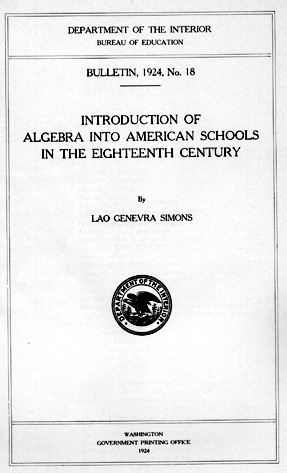Lao Genevra Simons
Introduction of Algebra into American Schools in the Eighteenth Century
Department of the Interior, Bureau of Education, Bulletin, 1924, No. 18

Preface
Certain periods in the making of history have been deficient in contemporary chronicles. This is notably true in the history of American education during the eighteenth century. Such history presents lessons to the educator of a later generation. As we follow the growth of the American people from the status of settlers in a new country to that of a distinctive nation with its own life to provide for by training and education, we are led to an understanding of the American character and civilization of our own day. This understanding is necessary for all those who are engaged in the attempt to prepare boys and girls to take their places in the present social structure.
The history of education is made up in part of accounts of various subjects which have developed into courses of study. mathematics of some kind has always been included in such courses. In the American Colonies arithmetic was an important subject for practical reasons. It was needed for trade and commerce. With sailing vessels plying between Europe and America and the only means of communication with the "homeland," navigation and all the kinds of sailing that had to be put to daily use came to be a continuation of the course in arithmetic. Astronomical observations were an important feature in laying out a course at sea, and so astronomy is found in connection with arithmetic. Some elementary trigonometry, logarithms, and geometric constructions played a necessary part in the calculations incident to both navigation and astronomy. With this list the practical uses of mathematics in that day are exhausted.
It is the purpose of this study to show that algebra, another branch of mathematics, entered into the American education of the eighteenth century, and to show further that we must seek some other reason for its presence than a practical need for it.
Table of Contents
- Foreign influences leading to the introduction of algebra into American education
English influence
English algebra - Algebra at Harvard in 1730
Arithmetic notebooks
Algebra notebooks
Isaac Greenwood
Samuel Langdon
James Diman
Introduction of the Harvard manuscripts
Symbols
Topics
Subject matter of an advanced nature
Geometric problems
Sources of material
Algebra in the Harvard course - The notebook of a Princeton student
Philip Vickers Fithian, 1770-1772
Saunderson problems
Hill problems
William Churchill Houston, professor of mathematics - A mathematical notebook from the University of Pennsylvania
"Mathematica Compendia"
Robert Patterson, professor of mathematics - Manuscript material from miscellaneous sources
Manuscripts by Robert Brooke
"Practical Mathematics"
Nathaniel Bowditch
End of the notebook custom - Commencement theses
A commencement custom
Account of the custom of printing Latin commencement theses
Yale mathematical theses in 1718
Algebra theses in 1718
Samuel Johnson and algebra at Yale in 1718
Algebra theses at Harvard in 1721
Fluxions at Harvard and Yale - Mathematical theses of Harvard College
General account
Algebra theses - College reports and writings of professors and presidents
Harvard requirements
Hugh Jones, professor of mathematics at the College of William and Mary
Thomas Clap, president of Yale College
Records of the University of Pennsylvania
William Smith, provost of the University of Pennsylvania
Laws and orders at Kings College (Columbia University) - Evidence of the use of foreign textbooks
Scarcity of printed books
The Young Mathematician's Guide, John Ward
The Elements of Algebra, Nathaniel Hammond
A Treatise of Algebra, Thomas Simpson - The first books containing algebra published in the new world
A Mexican algebra
A Dutch algebra—Arithmetica of Cyffer-Konst
Pieter Venama - Eighteenth century nooks on algebra by American authors
Algebra in the work of Nicolas Pike
The American Youth. Consider and John Sterry - Algebra and advertisements
Algebra in the public press
Private tutors and schoolmasters
Solutions of algebra problems
Sale of algebra books - Summary
A chronological list of American algebra textbooks to 1820
Bibliography
